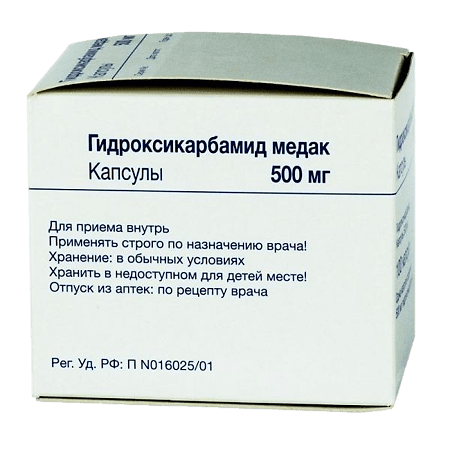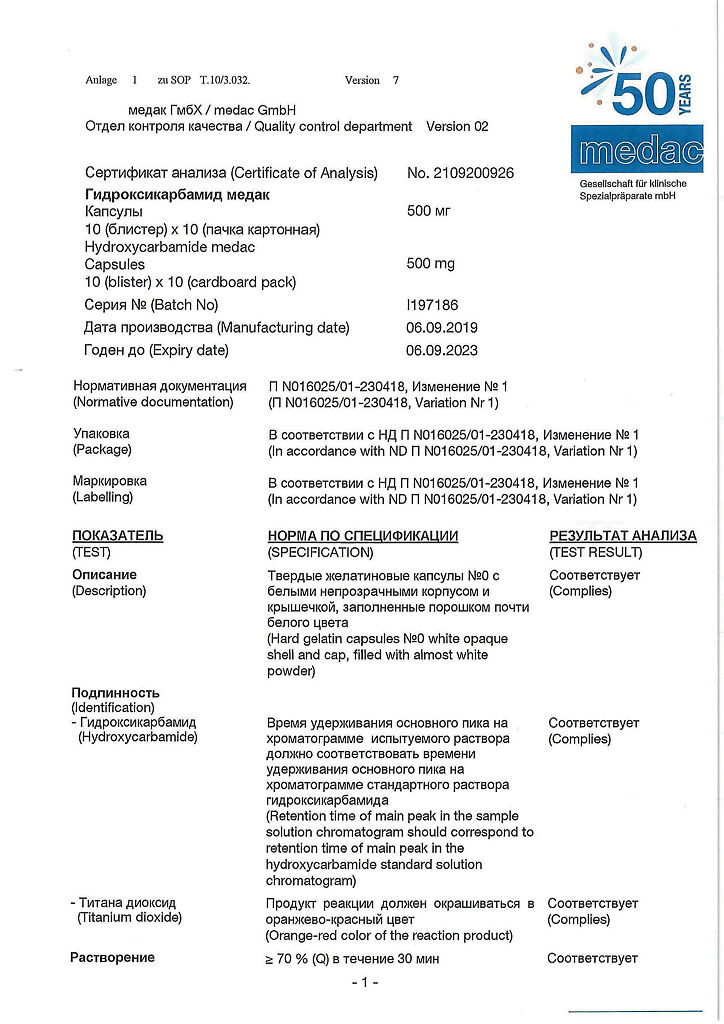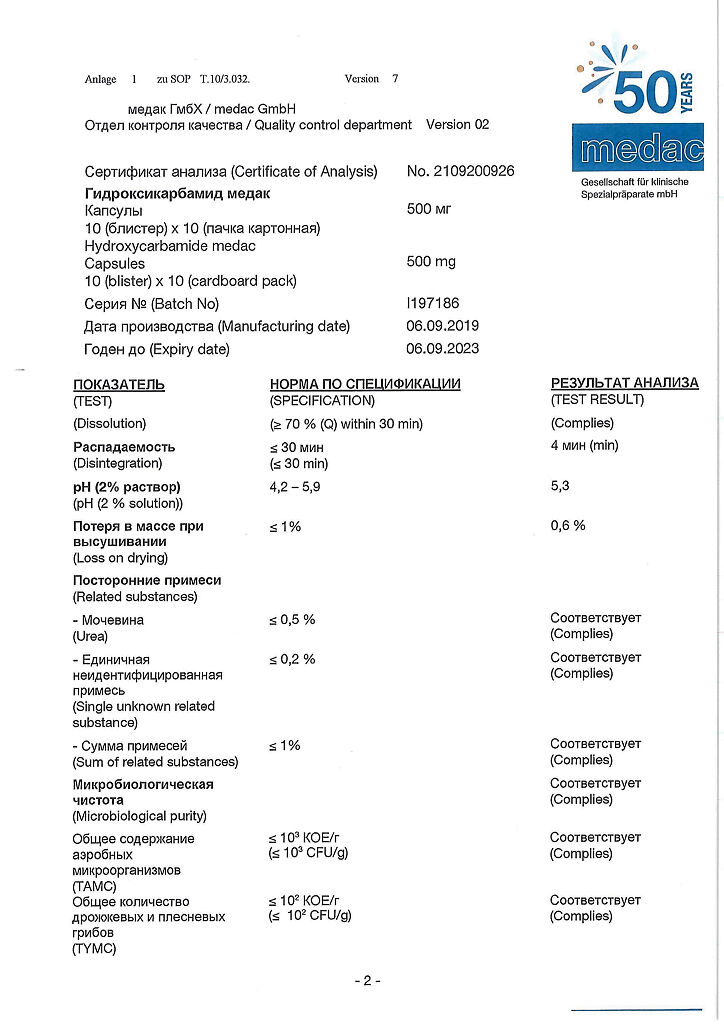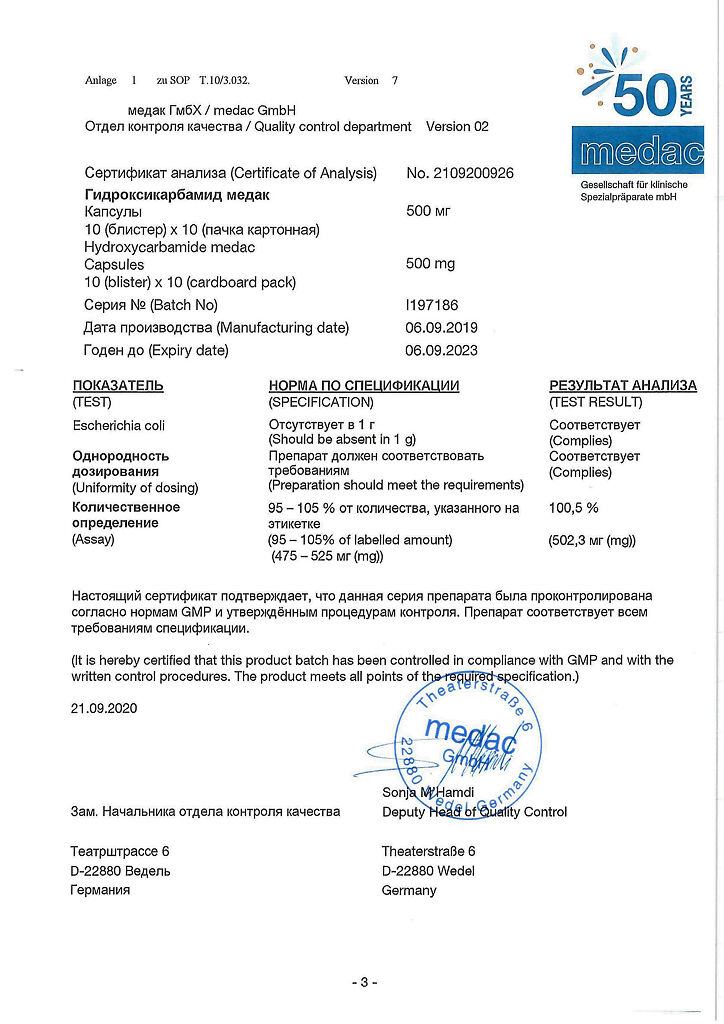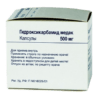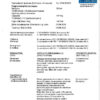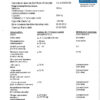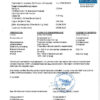No products in the cart.
Description
Pharmacodynamics
Hydroxycarbamide is a phase-specific cytostatic drug (antimetabolite, according to some reports – alkylating action) acting in the S phase of the cell cycle.
Blocks cell growth in interphase Gl-S, which is essential for simultaneous radiation therapy, because synergistic sensitivity of tumor cells in phase Gl to radiation appears. By enhancing the action of RNA reductase inhibitor – ribonucleoside diphosphate reductase, it causes suppression of DNA synthesis. The drug does not affect RNA and protein synthesis.
Pharmacokinetics
After oral administration the drug is quickly absorbed from the gastrointestinal tract. Cmax of the drug in blood plasma is reached 1-4 hours after ingestion. Food intake does not affect absorption of the drug. The drug is rapidly distributed throughout the body tissues, penetrates through the blood-brain barrier.
In cerebrospinal fluid it is determined 10-20%, in ascetic fluid – 15-50% of the concentration in blood plasma. T1/2 is 3-4 hours. Partially metabolized in liver and kidneys. 80% of hydroxyurea is excreted with urine within 12 hours, with 50% of it unchanged and small amounts of it as urea. The drug is also excreted through the respiratory tract as carbon dioxide. After 24 h there is no detectable in plasma.
Indications
Indications
Active ingredient
Active ingredient
Composition
Composition
Active ingredients:
Hydroxycarbamide 500 mg.
Auxiliary substances:
Lactose,
Calcium citrate,
Sodium citrate,
Magnesium stearate.
Composition of the shell:
gelatin, titanium dioxide.
How to take, the dosage
How to take, the dosage
The regimen and dosages should be guided by the literature in each individual case.
The drug is used orally.
In case of difficulty in swallowing, the capsule may be opened, the contents dissolved in a glass of water and drunk whole. Some water-soluble excipients may float on the surface of the solution.
A considerable amount of fluid should be taken during treatment with the drug.
Solid tumors
Head and neck carcinoma, cervical carcinoma
80 mg/kg once daily, every third day in combination with radiation therapy.
The treatment with the drug starts at least 7 days before the start of radiotherapy and continues during radiotherapy. After radiation therapy, the drug is continued indefinitely with close monitoring of the patient and in the absence of unusual or severe toxicity reactions.
Resistant chronic myeloleukemia
Continuous therapy. 20 to 30 mg/kg daily once daily.
The efficacy of the drug is evaluated after 6 weeks of treatment. If clinical remission is pronounced, treatment may be continued indefinitely. The treatment should be stopped if the leukocyte count is less than 2500/mm3 and the platelet count is less than 100000/mm3. Blood tests are repeated after 3 days. Treatment is resumed when the leukocyte and erythrocyte counts begin to increase markedly.
True polycythemia
The treatment starts with a daily dose of 15-20 mg/kg. The dose is adjusted individually, striving to keep hematocrit below 45% and platelet count below 400000/µl. In most patients it is possible to achieve these parameters by continuous use of hydroxycarbamide in a daily dose of 500 to 1000 mg.
Essential thrombocythemia
The drug is usually given at an initial daily dose of 15 mg/kg; the dose is then adjusted to maintain platelet counts below 600,000/µL without causing a decrease in white blood cell count below 4000/µL.
Interaction
Interaction
In concomitant use of the drug with other myelosuppressive drugs or radiation therapy, the degree of suppression of bone marrow function or the development of other side effects may increase.
The drug may increase uric acid in the blood, therefore it may be necessary to adjust the dose of drugs that increase excretion of uric acid from the body. Uricosuric agents increase the risk of nephropathy.
Special Instructions
Special Instructions
Treatment with this drug should be carried out under the supervision of a physician. Bone marrow, kidney and liver functions should be checked before and periodically during treatment with the drug. Hemoglobin, leukocytes and platelets should be determined at least once a week for the duration of treatment with the drug. If leukocyte count is less than 2500/μl or platelets less than 100000/μl, the treatment should be stopped until their content returns to normal.
The drug has cytotoxic action, so care should be taken when opening the capsules and avoid contact of the capsule powder with skin, mucous membranes or inhalation of the drug. If the contents of the capsule are accidentally scattered, immediately collect the powder with a napkin in a plastic bag, tie it up, and throw it away.
Anemia is not a contraindication for treatment with the drug. Severe anemia should be compensated before treatment with the drug.
Myelosuppression, mainly leukopenia, may develop during treatment with the drug. Thrombocytopenia and anemia develop less frequently and very rarely without preceding leukopenia. Anemia, even in severe form, is treated without interruption of treatment. Myelosuppression is most likely in patients after recent prior intensive radiation therapy or chemotherapy with other drugs. After recent intensive radiation therapy the drug should be used with caution due to possible exacerbation of postradiation erythema and increased severity of side effects (bone marrow aplasia, dyspepsia and gastrointestinal ulceration).
In the early stages of treatment with the drug, moderate megaloblastic erythropoiesis is often observed. The morphological changes resemble malignant anemia, but they are not associated with vitamin B12 or folic acid deficiency.
The drug may decrease plasma iron clearance and decrease the efficiency of iron utilization by erythrocytes, but it does not affect erythrocyte lifespan.
Patients should drink plenty of fluids during treatment. The drug should be used with caution in patients with impaired renal and hepatic function. It may be necessary to reduce the dose of the drug.
Contraindications
Contraindications
With caution: hepatic and/or renal insufficiency, anemia (should be corrected before starting treatment).
Side effects
Side effects
Hematopoietic disorders: leukopenia, anemia, thrombocytopenia.
Digestive system disorders: stomatitis, anorexia, nausea, vomiting, diarrhea or constipation, gastrointestinal mucosa ulceration. Increased activity of liver enzymes.
Skin and skin appendages: maculopapular rash, facial erythema and peripheral erythema, dermatomyositis skin changes. In some cases, as a result of daily use of the drug for several years, patients experienced hyperpigmentation, erythema, skin and nail atrophy, scaling, purple papules. In rare cases, alopecia and skin cancer have been observed.
Nervous system disorders: headache, dizziness, increased fatigue, drowsiness, disorientation; hallucinations and seizures are rare.
Urinary system disorders: increased levels of uric acid, blood urea nitrogen and creatinine in plasma, urine retention, interstitial nephritis. In rare cases, dysuria is noted.
Others: chills, general malaise, increased sedimentation, skin allergic reactions. Acute pulmonary reactions associated with the use of the drug have been reported in rare cases; diffuse pulmonary infiltration, fever and dyspnea.
Overdose
Overdose
When the drug is used in doses several times higher than recommended, patients develop signs of acute dermatological toxicity: soreness, purple erythema, edema with subsequent peeling of palms of hands and feet, intense generalized skin hyperpigmentation and severe acute stomatitis.
A specific antidote is not known. Treatment is symptomatic.
Pregnancy use
Pregnancy use
It is contraindicated in pregnancy and during breastfeeding.
Similarities
Similarities
Additional information
| Shelf life | 4 years |
|---|---|
| Conditions of storage | In a light-protected place, at a temperature not exceeding 25 °C |
| Manufacturer | Medac GmbH, Germany |
| Medication form | capsules |
| Brand | Medac GmbH |
Related products
Buy Hydroxycarbamide Medac, 500 mg capsules 100 pcs with delivery to USA, UK, Europe and over 120 other countries.

